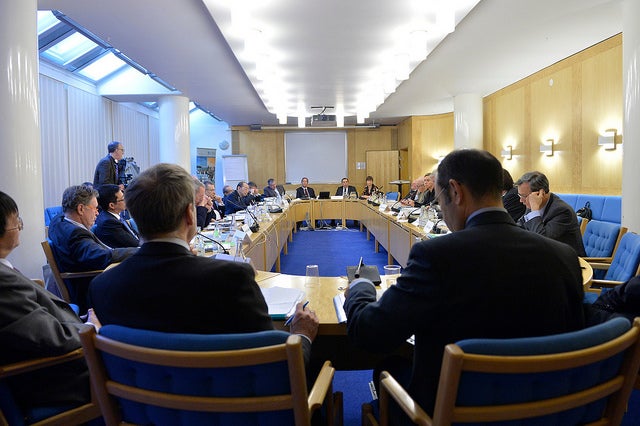NARUC Summer Meeting Highlights Clean Power Plan, Changing Utilities

The annual summer meeting of the National Association of Regulatory Utility Commissioners (NARUC) is a meeting of the minds like no other. Utility companies, regulators, staff, advocates, and trade press from around the country gather to discuss emerging trends and challenges, and it’s a great opportunity to understand what is on the collective mind of those empowered to oversee our country’s electricity system.
This month, over a thousand utility professionals attended the 2014 NARUC summer meeting in Dallas, which was dominated by two topics: the Environmental Protection Agency’s (EPA) proposed Clean Power Plan and the evolving utility business model.
This resulted in some very interesting conversations about changing the regulatory paradigm to incent the use of new technologies, optimize grid operations, and achieve reductions in greenhouse gas emissions.
Translating the Clean Power Plan into action
State utility regulators are still trying to understand the impact of the EPA’s proposed Clean Power Plan, released on June 2nd, 2014 with the intention of limiting carbon pollution from power plants for the first time in history. There is some puzzlement as to how each state goal for reduction was set. The application of the 2012 baseline year is being questioned. Enforceability and the availability of regional solutions to meet reduction requirements were also discussed.
Regulators want to know what will be required in excess of the trajectory they are already on. The Clean Power Plan is longer than 600 pages and contains a number of assumptions in setting individual state goals for reduction. Initial reactions reveal that many states believe further conversations with the EPA will be necessary to understand the agency’s goal for the 120-day comment period, which ends October 16th (CLICK HERE to learn more about how to comment on the proposed Clean Power Plan).
One tangible product that was developed during these meetings was a group statement by 51 former state regulators from across the country, including myself and EDF’s Cheryl Roberto, expressing our confidence in the ability of regulators and the regulatory system to execute on the tools offered in the Clean Power Plan.
Although there were individual statements of resistance and frustration expressed during the week, the majority of the meeting participants seemed intent on understanding the plan and laying the groundwork for eventual compliance. Many of the state regulators even talked about processes begun in their individual states in cooperation with the air regulators and other stakeholders to better comprehend the rule and prepare comments to the EPA for their state. Overall, the tone of these conversations at the NARUC summer meeting was constructive.
Utility leaders agree: Times are changing
The second major discussion dominating the meeting centered on utility business models. Spurred by the revolution of advanced energy technology, changing customer demands, the integration of more distributed generation on the central grid, and a record number of blackouts brought on by climate change, the regulatory framework for buying, selling, and distributing power in the U.S. is undergoing a fundamental change.
The discussion on utility business models began with a lengthy Sunday morning debate of the recent federal court ruling to rescind the Federal Energy Regulatory Commission’s (FERC) Order No. 745. The court’s decision was a setback for demand response, a clean energy resource that pays people and businesses to conserve energy during periods of peak or high demand. This ruling changes how demand response providers are compensated in wholesale energy markets, effectively devaluing demand response and reducing the incentive for providers to offer it as a service. Speakers and respondents in the Sunday meeting all agreed on the demonstrated value of demand response and the need for a solution to ensure its use if the order stands.
There were panels on business models and the value of solar, including discussions of the recent Minnesota value-of-solar proceeding, the first statewide program to fairly value investments in rooftop solar electricity generation. The ongoing New York proceeding, the first of its kind to re-envision a state’s utility regulatory framework, was also discussed extensively, both inside meeting rooms and in the hallways. Audrey Zibelman, Chair of the New York State Public Service Commission, appeared on a panel entitled “Modern Utility Industry, Modern Solutions.” Peter Kind revisited his January 2013 paper, Disruptive Challenges: Financial Implications and Strategic Responses to a Changing Retail Energy Business. This paper is credited with clearly outlining the impact of the technology revolution on the century-old utility business model. The consumer affairs committee asked how customer participation in energy markets can be optimized.
It’s no mistake the Clean Power Plan and changing utility business model were front and center at the 2014 NARUC summer meeting. These two topics will continue to dominate the utility sector over the next year and into the foreseeable future because of their complexity. The states’ ability to take full advantage of the tools and new technology offered by the EPA to meet the greenhouse gas reductions proposed in the Clean Power Plan are dependent on putting new business models into place that properly value clean, distributed resources and incent their use. Getting this right will require much more than an annual meeting of the minds, but it’s a start, and I look forward to seeing how the best ideas from this conference are implemented.










